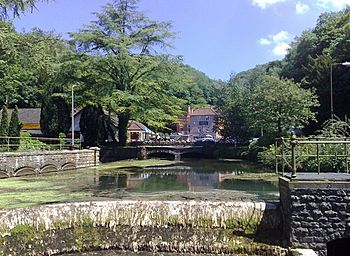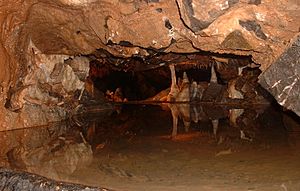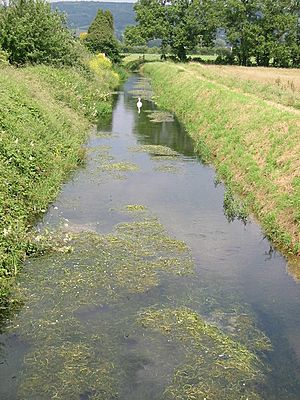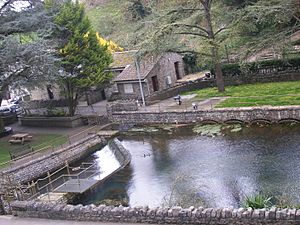Cheddar Yeo facts for kids
Quick facts for kids Cheddar Yeo |
|
|---|---|

The dam at the bottom of Cheddar Gorge
|
|
| Country | England |
| District | Somerset |
| Physical characteristics | |
| Main source | Cheddar, Somerset, England 51°16′54.45″N 2°45′58.93″W / 51.2817917°N 2.7663694°W |
| River mouth | River Axe Near Rackley, Somerset, Somerset, England 51°17′22.96″N 2°53′30.37″W / 51.2897111°N 2.8917694°W |
The Cheddar Yeo is a small but amazing river in Somerset, England. What makes it special is that a big part of it flows underground! It forms the largest underground river system in Britain, hidden beneath the Mendip Hills. After its underground journey, it pops out into the famous Cheddar Gorge. The river then flows through the village of Cheddar. Long ago, people used the river's power to run mills. It even had ports for ships, but it's not used for boats anymore. Today, some of its clean water is sent to Cheddar Reservoir to provide drinking water for the city of Bristol.
Contents
The River's Journey

The Cheddar Yeo starts from a spring near Charterhouse. Then, it disappears under the Limestone rocks of the Mendip Hills. It reappears inside Gough's Cave, a famous cave in Cheddar Gorge.
Underground Adventures
Inside Gough's Cave, the river creates Britain's largest underground river system. Imagine a hidden world of water! Brave cave divers have explored parts of this amazing underground river. They go through narrow passages and deep underwater tunnels called sumps.
One passage, called Dire Straits, leads to a wide river passage. Divers have explored this passage for hundreds of meters. Further dives lead to large underground rooms like Lloyd Hall and Bishop's Palace. Bishop's Palace is the biggest room found so far in the Cheddar caves. It's about 60 meters long and 25 meters wide, filled with huge rocks.
The river continues through more sumps, some very deep. One sump is about 55 meters deep, reaching far below sea level! After these underwater sections, the river flows through wide passages before reaching a blockage.
Flowing Through Cheddar
After leaving Gough's Cave, the river flows through the village of Cheddar. It passes by the site of an old Saxon palace, which is now part of The Kings of Wessex School. There's also a 14th-century chapel nearby. Even older Roman remains have been found here.
The river then flows south under an old railway bridge. This bridge used to carry the Cheddar Valley line. Finally, it flows west through a place called Rackley before joining the River Axe. The area of land that collects water for the Cheddar Yeo is about 54 square kilometers.
A Look Back in Time
The Cheddar Yeo has been important to people for a very long time.
Mills and Factories
Records from as early as 1527 show that watermills were built on the river. These mills used the river's power to grind corn and make paper. At its busiest, there were 13 mills on the Yeo. By the 19th century, the area also became known for making clothes. The last mill in Cheddar, which was a shirt factory, closed in the early 1950s.
Busy Ports
In the Middle Ages, Rackley was a busy trading port. A wharf (a place for ships to load and unload) was built there in 1200. In 1324, King Edward II even made Rackley a borough, which is like a town with special rights. However, by the end of the 14th century, the port started to decline.
Despite this, ships still used the river. In the 14th century, a French ship sailed up the river. Later, a merchant from Wells used Rackley to send cloth and corn to Portugal. In return, he received iron and salt. Slate was also brought in through this route. There was another small port at Hythe, just south of Cheddar, which was used until the 19th century.
Cheddar Reservoir
Some of the water from the Cheddar Yeo is sent to Cheddar Reservoir. This is a large, round, man-made lake run by Bristol Water. It helps provide drinking water for people in the area. You can see the big grate where the water pipe starts, near the sensory garden in Cheddar Gorge.
The reservoir was built in the 1930s. It can hold a huge amount of water – about 135 million imperial gallons! This reservoir is also a special place for nature. It's called a Site of Special Scientific Interest (SSSI) because many different kinds of waterfowl (birds that live on water) spend their winters there.
In 2007, there was talk about building another reservoir near the existing one. This new reservoir would be about the same size and built on the flat land near the Cheddar Yeo.
River Health
The Environment Agency checks the health of the Cheddar Yeo. In 2016, they said the river's water had a moderate ecological quality. This means it's okay for plants and animals, but there's still room for improvement. However, it did not pass the chemical assessment that year.
Gallery









